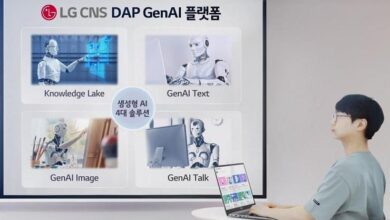31 of the Latest Generative AI Infrastructure Statistics in 2024

Generative artificial intelligence (AI) infrastructures make it easier to develop and deploy scalable generative models. They combine natural language understanding and machine learning (ML) technologies to help organizations aggressively create an efficient, scalable, and secure training environment.
Many companies use generative AI infrastructure software to overcome model scalability challenges while facilitating high inference speed and availability. It’s crucial for using large language models (LLMs) and other generative AI technologies.
Here are a few stats about the state of generative AI infrastructure in 2024.
Generative AI infrastructure statistics
These statistics showcase how companies are using and increasing their adoption of generative AI infrastructure. Take a look at what frameworks professionals prefer for model customization.
- AI servers are expected to generate revenue of $132 billion under hardware sales.
- A survey of 50 tech businesses revealed that 64% plan to adopt generative AI technologies.
- The AI infrastructure market, valued at $23.5 billion in 2021, is estimated to rocket to $309.4 billion by 2031, growing at a 29.8% compound annual growth rate (CAGR) from 2022 to 2031.
- The broad adoption of open source frameworks for model customization shows a high satisfaction rate. It suggests flexibility in AI infrastructure is essential to meet increasing demands. More than 78% of respondents are satisfied or very satisfied with their current solution, indicating that open source frameworks provide respondents with what they need.
93%
of survey respondents indicated that the ability to self-serve real-time compute resources would greatly improve their organization’s AI team productivity.
Source: AI Infrastructure
- Companies’ primary methods for maximizing graphical processing unit (GPU) utilization include queue management and job scheduling (67%), multi-instance GPU setups (39%), and setting usage quotas (34%).
- Users’ techniques for optimizing GPU allocation vary. Twenty-four percent use open-source solutions, 27 percent use high-performance computing (HPC) solutions, and 34 percent use vendor-specific solutions. Additionally, 11 percent rely on Microsoft Excel, and five percent on custom-built solutions.
- To monitor GPU utilization, 36% of companies use Google Cloud Platform-GPU metrics as their main method, followed by 30% using NVIDIA AI Enterprise.
- Other tools like the IBM load-sharing facility (LSF) and Kubernetes were used by 15% and 13% of respondents.
Top generative AI growth and adoption statistics
These statistics show how AI is generally growing and how people perceive it. Understanding these statistics will help you assess upcoming opportunities in the sector and the infrastructure needs that might arise.
Go through these data points to absorb people’s real perceptions of AI. See how men use AI differently than women or children.
- In 2022, the generative AI market was valued at $29 billion.
- The value of the generative AI market is projected to surpass $66 billion by the end of 2024.
- A report predicts that the generative AI market could reach a staggering $1.3 trillion by 2032.
- North America dominates generative AI revenue with a 40.2% global share, mainly due to the presence of major tech firms like Microsoft, OpenAI, Meta, Adobe, IBM, and Google.
2,620
global businesses had 94% of executives believe AI will enhance their operations over the next five years.
Source: Deloitte
- The usage of AI varies, with 44% of companies employing it for cloud pricing optimization and 41% of firms using it for voice assistants and chatbots.
- A poll of 821 businesses indicated a potential cost reduction of 15.7% over the next 12 to 18 months through generative AI investments.
- Chatbots save an average of 2 hours and 20 minutes daily, while generative AI in customer service response writing saves businesses about 2 hours and 11 minutes daily.
- Men are twice as likely as women to use generative AI, with significant differences in the usage of platforms like ChatGPT, which averaged 1.5 billion monthly visits in 2023.
- Regarding children’s use of AI chatbots like ChatGPT, 31% of men versus only 4% of women feel comfortable allowing their children to use these technologies for any purpose.
- The marketing and advertising industry leads in generative AI adoption, surpassing even the tech sector, with respective adoption rates of 35% and 30% in consulting, 19% in teaching, 16% in accounting, and 15% in healthcare.
Concerns about generative AI infrastructure and systems
Amid rising interest in artificial intelligence technologies, some organizations are deeply concerned about its impact on security. Some companies have worries related to its cost and computational limits.
- 58% of organizations have not adopted AI due to cybersecurity concerns.
- Key cost drivers in generative AI include integration and GPU expenses for model development and training. Still, 56.8% of companies expected double-digit increases in revenues from AI/ML investments and AI transformation in 2024.
- Companies actively seek cost-effective alternatives to GPUs for AI inference to manage compute limitations, which remain a top challenge.
- In managing GPU resources, companies employ various strategies, including queue management and job scheduling, with a notable 78% utilizing over half of their GPU resources during peak times.
63%
of tech leaders and executives face challenges with scheduling and job management, 52% are grappling with model training solutions, and 36% with model serving.
Source: AI-Infrastructure
- 74% of survey respondents believe integrating computers and scheduling into a single platform would be beneficial. Such integration supports quicker and more efficient development and deployment of models.
- As companies plan for higher compute demands in 2024 and aim to use LLMsin production, executives are weighing their current challenges against future needs, particularly considering the scarcity of GPUs for inference tasks.
- Model serving enables access to machine learning models via application programming interfaces (APIs), which is crucial for AI-integrated applications. About one-third of companies do not have model-serving capabilities, which are increasingly necessary due to the demanding performance needs of generative AI models.
- 61% of survey participants are somewhat dissatisfied with their current scheduling tools, and 12% feel neutral, suggesting significant potential for improvement.
- The main issues with current tools include inadequate GPU optimization (53%) and user-friendliness for developers and data scientists (47%). Additionally, about 25% report issues with control and compatibility with existing AI/ML stacks.
Generative AI’s future prospects
The future of AI seems bright and promising, with several companies planning to expand their AI and automation capabilities. The stats below reflect this.
- Almost all surveyed companies (96%) plan to expand their AI computing capabilities, focusing on cloud solutions due to their flexibility and speed, despite concerns over wastage and idle costs.
87%
of IT leaders are planning more automation in the next year and a half, despite 58% being dissatisfied with current levels of automation.
Source: Salesforce
- 5% to 10% of enterprises have begun integrating generative AI into their production processes.
It’s an AI-enabled future for tech
The demand for AI infrastructure will rise as more companies build and expand the deployment of AI systems in their operations. Presently, there are a few concerns related to costs and security. However, as technology improves, these concerns will likely turn into business opportunities for leaders to address.
Learn more about trends in artificial intelligence and future predictions.



